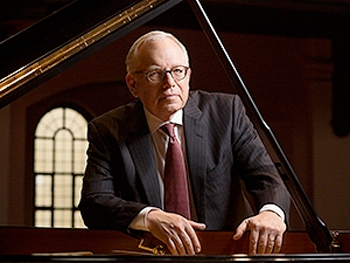by Jarrett Hoffman

Takács opened with Beethoven’s own closer — the Six Bagatelles, Op. 126, were the last pieces he composed for solo piano. The first of these miniatures sounded as content as an old couple seated in their preferred chairs. The fourth, which begins low and angry, then runs the spectrum to sweet and playful, brought out the pianist’s most poetic side. His ending, hesitant and trailing off, seemed to recall one of those distant memories that somehow always makes you look out the window.
Soovin Kim joined Takács for Beethoven’s tenth violin sonata in G, the pair trading the luxurious trills that open the work. The duo partnered perfectly, each musician sensitive and full of ideas. Kim’s playing, full of character in the simplest and most complex passages, seemed to grin just as he did. Gracious applause met the movement’s close.
Beautiful counterpoint in the piano opens the second movement, Adagio espressivo. Kim soon joined with a lyrical sound before showing off his flexibility with a wispy timbre — though this never developed into a meaningful musical idea. A cheeky Scherzo, then a hoedown of a finale — packed with syncopation, plot twists, and adrenaline — rode us to intermission.
Takács’s next guest, tenor Virgil Hartinger, sang Beethoven’s only song cycle, An die ferne Geliebte, Op. 98. Hartinger’s rich, clear voice was on display from the start, and a breathtaking accelerando closed the first song. Takács, a sensitive collaborator all evening, shaped a beautiful transition into the second song. Here, Hartinger’s tone was static. He could have done more with the second stanza — beginning “Dort im ruhigen Tal” (There in that quiet vale) — sung entirely on a single note. His hushed intensity at the end of the third song was excellent, and he brilliantly underlined the cycle’s circular form with his sighing sound at the beginning of the final piece — as if to say, Ah, here we are!
Beethoven’s last piano sonata closed the program. The creepy-crawly, “haunted-house” theme, almost campy to the modern ear, felt nuanced in his hands. His variety of touch and awesome sense of pacing made up for some memory slips that would crop up throughout the sonata. After a gorgeous pause, he waded into the epic second movement. Like a stream of consciousness flowing from the downright groovy to moments of stargazing wonder, the performance showed two spirits — Beethoven and Takács — both of them loving, enjoying, and still in awe of the world.
Published on ClevelandClassical.com January 19, 2016.
Click here for a printable copy of this article



